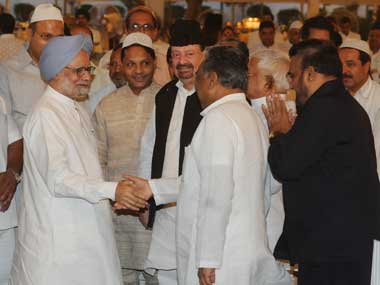There’s a predictable familiarity about India’s performance in this year’s Global Competitiveness Report from the World Economic Forum: India has once again slid down three notches to 59th place among 144 countries.
The index, which is a measure of the ease of doing businesses in countries around the world as adjudged on different parameters, offers a fair summation of India’s strengths and weaknesses relative to other economies. For a country that is edging into the world’s top 10 economies by sheer size and which accounts for 5.6 percent of global GDP, India’s performance comes across as at best middling. In any case, it is a serious underperformer.
[caption id=“attachment_444685” align=“alignleft” width=“380”]  Difficult times for Prime Minister Manmohan Singh. PTI[/caption]
Since 2009, when India peaked at 49th place, it has slipped 10 notches, a dramatic fall that reflects the policy paralysis that has afflicted the UPA 2 government and has dragged down economic activity to its slowest pace in nearly a decade.
India, which was at one time ahead of both Brazil and South Africa, now trails them by about 10 places. For all its claims to being in the ‘China league’, India lags behind China by about 30 places. In many ways, it is the laggard among the BRICS economies.
When you drill down into the data, it’s very clear that it is misgovernance that is holding India back from realising its potential and blunting its competitive edge. On the areas that are considered “basic factors” that influence competitiveness-that is, infrastructure in respect of transport, communication, and energy-India scores particularly badly, ranked 84th among 144 countries. “Indeed, the Indian business community repeatedly cites infrastructure as the single biggest hindrance to doing business, well ahead of corruption and bureaucracy,” the report notes.
On other parameters such as health and basic education, India fares even worse, coming in at an unpardonable 101st place. To be fair, some of these are issues on which it is difficult to see anything other than inter-generational change; and there has been a slow improvement in recent years.
Yet, the failure to provide even basic services for much of the population-indicatively, only 34 percent of the population had access to sanitation-points to a serious failure of governance. The absence of social safety nets renders much of the population and the country vulnerable to economic shocks. “In addition”, the report adds, “although no official dataare reported for youth unemployment, numerous studies indicate that the percentage is very high. In terms of itsenvironmentally sustainable competitiveness, India alsohas some areas of concern such as its high agriculturalwater intensity and significant air pollution.”
More proximate failures of governance have also contributed to India’s slide down the competitiveness index. Public trust in politicians has eroded considerably in the past three years, and India, which was once ranked 37th on this parameter, has slid to 106th place, even lower than Pakistan.
The report’s findings in respect of particular aspects of misgovernance tally with the lived reality that many of us know. For instance, on the index that gauges the extent of diversion of public funds to companies, individuals or groups due to corruption, India ranks pretty poorly.
On another index that measures how common it was for companies to make “undocument extra payments”-or bribes-in respect of routine business or due process matters, India ranks a lowly 99th.
On other governance-related issues too, India is more in the banana republic range: it is ranked 92nd on the extent of favouritism in government decisions; 63rd on the extent of wastefulness in government spending; 98th on the extent to which government regulation is burdensome for industry.
Given the fragile security in India, the country also performs very badly on an index that measures the “business cost of terrorism”, coming in at Rank 114.
The business community in India continues to be riddled with angst over the absence of economic reforms, and the government’s inability to push them through. All of that is dragging down the macroeconomic environment (on which count India is ranked 99th), which is cramped by high public debt, and the highest debt-to-GDP ratio among BRICS countries.
The only saving grace for India is its relatively sophisticated financial market (on which count it is ranked 21st) and the reasonably innovative businesses (rank 41).
Overall, the report validates the view that failure of governance-in general over the decades and, more particularly, in the past three years-has caused grievous harm to India’s competitiveness as a place for doing business. A failure to get the basics right is costing India dearly.


)
)
)
)
)
)
)
)
)



